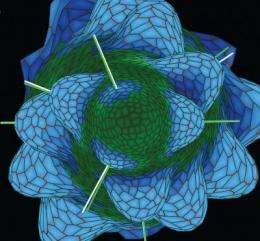Is your leaf left-handed? Previously overlooked asymmetry in Arabidopsis and tomato leaves

Research published in the Plant Cell shows that the spiral pattern of leaf formation from the point of growth affects the developing leaf's exposure to the plant hormone auxin; This exposure leads to measurable left-right asymmetry in leaf development, in species previously assumed to have symmetric leaves.
The front of a leaf is different from the back of a leaf and the tip is different from the base. However, a leaf from a tomato or an Arabidopsis plant superficially appears to be bilaterally symmetrical, or the same on the left and right sides. Don't let its appearance fool you; there is an underlying asymmetry between the left and right sides of such leaves—it just took a while for scientists to discover it. The story begins with the mechanism by which leaves form along a stem. In broad-leafed plants, dicots, leaves form from the meristem, an actively dividing tissue at the top of the plant, so that as you look down the stem, the oldest leaves are at the bottom. Leaves don't just become arranged by random chance either—phyllotaxis, the arrangement of leaves or flowers along a stem, affects key plant characteristics, such as how much light can filter through to lower leaves. Leaves can form opposite each other, or in alternation, or in whorls; often leaves form in spirals where the next leaf is offset by roughly 137 degrees, known as the "golden angle", which is related to the Fibonacci sequence.
Recent research has shown that leaf initiation in the meristem is specified by locally high concentrations of the plant hormone auxin. In a study published in The Plant Cell, an international group coordinated by Neelima R. Sinha, Ph.D., of the University of California at Davis, examined how the pattern of auxin concentrations might affect the symmetry of the leaf. She explains, "As leaves are initiated within a spiral context, we might expect that they would be asymmetric and exhibit the same handedness of the spiral, like propeller blades. Yet, superficially many leaves appear symmetrical." To examine whether the spiral pattern of leaves affected symmetry, her team first modeled the anatomy of the forming leaves and the location of the highest concentrations of auxin, finding that the two were not perfectly aligned. Following up, they found that this difference caused asymmetry at both the molecular level, altering gene expression, and the anatomical level, altering leaf shape, in tomato and Arabidopsis thaliana leaves. Indeed, the authors found measurable anatomical differences between the left and right sides of both young and mature leaves, identifying a previously overlooked axis of asymmetry.
Dr. Sinha summarizes: "Our results show that asymmetry is indeed very much present in the leaves around us and that the spiral, within which they are initiated, influences their development from the earliest stages. Quite literally, the handedness of the spiral in plants transmits its asymmetry to leaves. By studying these asymmetries, we can begin to understand the mechanisms by which plants produce such a staggering array of leaf shapes in such regular arrangements."
More information: www.plantcell.org/content/earl … 98798.full.pdf+html/
Journal information: Plant Cell
Provided by American Society of Plant Biologists


















